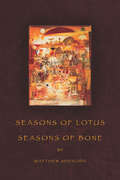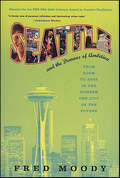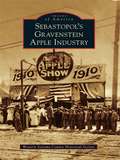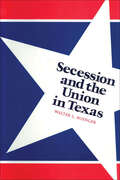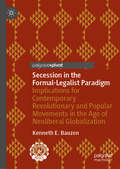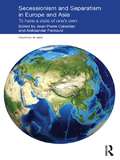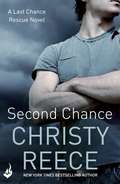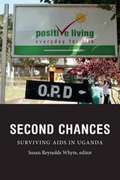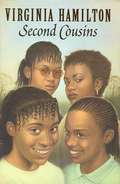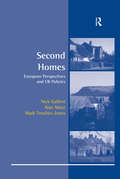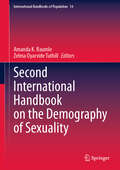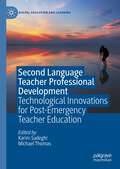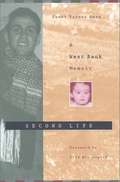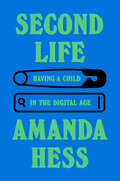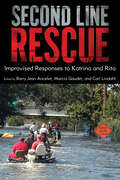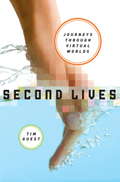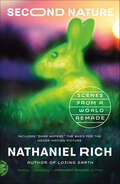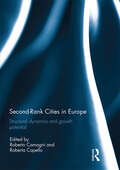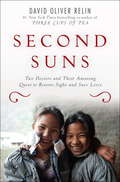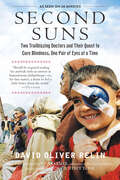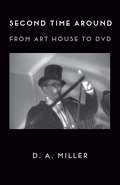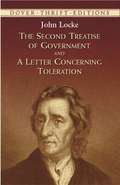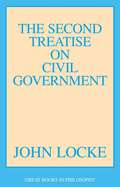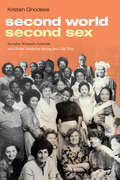- Table View
- List View
Seasons of Lotus, Seasons of Bone (American Poets Continuum)
by Matthew ShenodaWeaving narratives of ancient and contemporary Egypt while exploring ecological shifts of the Nile Valley, Matthew Shenoda is a voice at the crossroads of the African continent and its diasporas. Amiri Baraka says, "Matthew Shenoda’s poetry will open your mind to another world that exists inside and outside of your own." Winner of the 2006 American Book Award for his debut collection, Somewhere Else, Shenoda is a younger poet with his eyes set on the larger issues of history, politics, and culture.Matthew Shenoda lives in Los Angeles, California. He is on the faculty of the MFA program at Goddard College.
Seattle and the Demons of Ambition
by Fred MoodyFounded in 1851 as a four-cabin outpost named "New York Pretty-Soon," Seattle has long struggled with an identity crisis. From a nearly lawless port, to a sedate, conventional company town defined by Boeing Aircraft, to an accessible paradise for artists and recovering urbanites, Seattle repeatedly tried and failed to become bigger, wealthier, more like "major league" cities.In the late 1980s, Seattle's time suddenly arrived. Microsoft, Amazon, Starbucks, McCaw Cellular/AT&T Wireless, and dozens of local dot.com startups began to drive a booming national economy. Seattle became a city of instant millionaires and brand name shopping, skyscrapers and sports franchises-- the place everyone wanted to visit, topping lists of America's "most desirable" cities. But with such wealth came consequences: overdevelopment, paralyzing traffic, racial and class divisions, and a street population of teenagers discarded by the new culture, whose rage and disaffection fueled the rise of bands such as Nirvana. Striving to reach its ambitions, Seattle seemed to be losing the struggle for its soul. And when it hosted the 1999 World Trade Organization convention, the city's conflicted personalities clashed, as violent riots by residents and a coalition of protestors left the downtown decimated and the nation transfixed by the spectacle of globalization gone wrong. In Seattle and the Demons of Ambition, Fred Moody uses his own background as a native son, along with wide-ranging encounters with others, to trace the growing pains of the city he loves. Profiling Bill Gates and never-quite-champion football coach Chuck Knox, a pair of ambitious entrepreneurs and a homeless sculptor once profiled in the New Yorker, grunge music superstars and the preyed-upon children of the documentary "Streetwise," Moody offers a dramatic, entertaining, and insightful portrait of the city that defined economic and technological change in the America of the 1990s
Sebastopol's Gravenstein Apple Industry
by Western Sonoma County Historical SocietyThe Gravenstein apple has been etched into the identity of Sebastopol, California, which is one of the few places on earth to have extensively grown this elusive apple. The Gravenstein is an early apple whose only failing is perishability, but it is celebrated for its superior flavor. Yet Luther Burbank attempted to improve on the Gravenstein, producing the Winterstein and the Bonita for home gardeners. During the last 127 years, the Gravenstein has added millions of dollars to the local economy. It has provided a reason for celebrations, from the 1910 Apple Show to today's Apple Blossom Festival and Gravenstein Apple Fair. This is the Gravenstein's story, from its European roots to small-town homage, and the part this special apple has played in one community--and the reason the current decline in apple acreage is mourned.
Secession and the Union in Texas
by Walter L. BuengerThis history of secession in the Lone Star State offers both a vivid narrative and a powerful case study of the broader secession movement.In 1845, Texans voted overwhelmingly to join the Union. Then, in 1861, they voted just as overwhelmingly to secede. The story of why and how that happened is filled with colorful characters, raiding Comanches, German opponents of slavery, and a border with Mexico. It also has important implications for our understanding of secession across the South.Combining social and political history, Walter L. Buenger explores issues such as public hysteria, the pressure for consensus, and the vanishing of a political process in which rational debate about secession could take place. Drawing on manuscript collections and contemporary newspapers, Buenger also analyzes election returns, population shifts, and the breakdown of populations within Texas counties. Buenger demonstrates that Texans were not simply ardent secessionists or committed unionists. At the end of 1860, the majority fell between these two extremes, creating an atmosphere of ambivalence toward secession which was not erased even by the war.
Secession in the Formal-Legalist Paradigm: Implications for Contemporary Revolutionary and Popular Movements in the Age of Neoliberal Globalization
by Kenneth E. BauzonThis book explores how formal-legalism, as the dominant paradigm of explanation, has sought to explain the phenomenon of secessionism among its practitioners as a problem for the modern state. This study bears how these practitioners have, over time, described, defined, and proposed to solve secessionism and related political problems within the logic of their paradigm. In the process, the book reconstructs the formalist worldview and the practitioners’ fundamental presuppositions which, to them, render comprehensible and meaningful the occurrence of events, like secession, as well as means of dealing with it. More significantly, the book exposes a debilitating flaw of formal-legalist paradigm as it fails to account for other principles of mobilization in political and social life that defy formal-legal rules such as those based on race, ethnicity, language, culture, and material factors. Narrow adherence to textual sources and the literal approach, have led formal-legalists to miss, willfully ignore, or endorse the paradigm's strategic association with state power, evolving since the dawn of the Enlightenment. Formal-legalism has lent itself amenable to the interests of the state and to the variable construction of the meaning of the law devoid of original spirit and universality but conforming with the specific interests of the state or, for that matter, the prevailing American empire, both spatially and temporally. Accounting for this anomaly, the historical materialist perspective is considered, with appropriate historical and contemporary illustrations, as a relevant explanatory alternative to the now-obsolescent formal-legalist paradigm. With the assumption that, indeed, economic and material considerations such as those demanded by the dominant class elements within the state underlie the rationale for the state, formal-legalism has evolved from one that initially provided a presumed objective view of society to one that has subjectively become an essential part of the cultural suprastructure that allows these elements to command the state as a principal tool for labor- and value-extraction during what is popularly known as contemporary neoliberal globalization.
Secessionism and Separatism in Europe and Asia: To Have a State of One’s Own (Politics in Asia)
by Jean-Pierre Cabestan Aleksandar PavkovićThe boundaries between secessionism and separatism are often blurred, and in many cases study of secessionism encompasses that of separatism and vice versa. Recognising this inherent relationship, this book provides a comparative survey of recent attempts at secession and separatist movements from across Europe and Asia, and assesses the responses of the respective host governments. The essays address two main questions which arise from the relationship between state governments and secessionist movements: first, how secessionist or separatist movements gather support and mobilize their target populations and second, how central political authorities respond to the challenges that secessionist or separatist movements pose to their capacity to control the country. With political analysis of recent cases ranging from the Balkans, the USSR, the UK and the Basque Country, to Sri Lanka, Burma, China, Tibet and Taiwan, the authors identify both similarities and differences in the processes and outcomes of secessionist and separatist movements across the two distinct regions. This volume will be an invaluable resource for those who wish to understand the dynamics of secessionist movements and as such will appeal to students and scholars of Asian and European politics, comparative politics, international relations and conflict studies. It will also be helpful to practitioners and policy-makers who wish to understand and contribute to the resolution of such conflicts.
Second Chance: Last Chance Rescue Book 5 (Last Chance Rescue)
by Christy ReeceFor fans of Maya Banks, Nina Bruhns, Pamela Clare and Julie Ann Walker. The fifth novel in New York Times bestselling author Christy Reece's addictive Last Chance Rescue series of sexy suspense and thrilling adventure. Working for Last Chance Rescue, Cole Mathison has been to hell and back. But being responsible for the death of an innocent man is a hell like no other. Longing for redemption, Cole finds himself embroiled in the mysterious disappearance of Keeley Fairchild's young children. Rescuing the children is his mission - but falling in love with the widow of the man he inadvertently killed was never in the plans. When Keeley's life is threatened, Cole's demons must take a backseat to the most important mission of his life. He might never know the heaven of Keeley's arms, but he'll never survive the hell of failing to save her.Don't miss the other pulse-pounding novels in the Last Chance Rescue series, Rescue Me, Return To Me, Run To Me, No Chance, Last Chance, Sweet Justice, Sweet Revenge, and Sweet Reward, or the steamy southern suspense of the Wildefire series by Christy's alter-ego Ella Grace which begins with Midnight Secrets.
Second Chances: Surviving AIDS in Uganda
by Susan Reynolds WhyteDuring the first decade of this millennium, many thousands of people in Uganda who otherwise would have died from AIDS got second chances at life. A massive global health intervention, the scaling up of antiretroviral therapy (ART), saved them and created a generation of people who learned to live with treatment. As clients they joined programs that offered free antiretroviral medicine and encouraged "positive living." Because ART is not a cure but a lifelong treatment regime, its consequences are far-reaching for society, families, and individuals. Drawing on personal accounts and a broad knowledge of Ugandan culture and history, the essays in this collection explore ART from the perspective of those who received second chances. Their concerns about treatment, partners, children, work, food, and bodies reveal the essential sociality of Ugandan life. The collection is based on research undertaken by a team of social scientists including both Western and African scholars.Contributors. Phoebe Kajubi, David Kyaddondo, Lotte Meinert, Hanne O. Mogensen, Godfrey Etyang Siu, Jenipher Twebaze, Michael A. Whyte, Susan Reynolds Whyte
Second Cousins
by Virginia HamiltonIn this spellbinding sequel to a best-selling novel, cousins Cammy Coleman and Eloise Odie are forced to face some dark family secrets when their second cousins visit from New York City.
Second Grade Studies Weekly, [Grade] 2 Social Studies
by Inc. American Legacy PublishingNIMAC-sourced textbook
Second Homes: European Perspectives and UK Policies (Routledge Revivals Ser.)
by Nick Gallent Alan Mace M Tewdwr-JonesSecond homes are once again a source of political and social contention in rural areas. The British government's decision to reduce Council Tax discounts on second homes in England in April 2004 has caused wide debate in local communities, local authorities, and the media. The debate has not only focused on the vexed Council Tax issue, but on wider rural housing concerns. Questions have been raised as to whether second homes are a major cause of housing affordability problems in rural areas, and whether they lead to the displacement of local people in rural communities. In the face of anecdotal evidence being presented to answer these questions, Second Homes: European Perspectives and UK Policies, offers a more comprehensive analysis of the second homes question as it now exists. This up-to-date and authoritative analysis of second homes draws on the latest research and offers a critical insight into current housing problems in rural communities. Those interested in rural and housing studies will find the book valuable.
Second International Handbook on the Demography of Sexuality (International Handbooks of Population #14)
by Amanda K. Baumle Zelma Oyarvide TuthillA decade after the publication of the first International Handbook on the Demography of Sexuality, there have been fundamental shifts in how we measure sexual and gender identities and the breadth of available population-level sexuality data. The chapters in this second edition of this handbook provide guidance on methodological approaches involved in studying population sexuality, as well as insight into the ways that sexuality shapes key demographic outcomes. Chapters examine how we measure sexual identities and behaviors on surveys, sexuality changes across the life course, international perspectives on sexual behaviors and identities, and the ways that sexual identities shape families, labor market experiences, and health outcomes. Despite these developments, we still know relatively little about key demographic questions related to fertility and migration for sexual minorities, as well as about understudied topics of sexuality that fall outside of risk-focused analyses. In particular, much of our understanding of sexuality has been motivated by controlling the spread of sexually transmitted infections or adolescent pregnancies, rather than understanding motivations for sexual interactions, such as pleasure. Accordingly, although the research set forth in this book provides insight into existing knowledge of sexual behavior and of sexual minority populations, the chapters also point researchers and policymakers toward needed areas of research and data collection.
Second Language Teacher Professional Development: Technological Innovations for Post-Emergency Teacher Education (Digital Education and Learning)
by Michael Thomas Karim SadeghiThis edited book brings together documented evidence and theoretical propositions on the essential mediating role of digital technology in L2 teacher education and professional development. Topics range from technological affordances in teacher education, to challenges and responses to emergency transition from face to face to virtual professional development, to successful practices of online teacher training courses. Bringing together examples from various countries and contexts of how L2 teacher trainers and trainee teachers view these forced changes and react to them, the volume fills a gap in the use of digital technology in contexts where teacher educators and trainee teachers are not technology-literate and not prepared for technology-oriented education. In addition to a Foreword by Mark Warschauer and Introduction and Conclusion chapters by Editors, the volume features 13 full-length chapters by some of the well-known experts from countries such as Australia, Finland, Mexico, the UK, the USA, Spain, Singapore, Turkey and Sweden.
Second Life: A West Bank Memoir
by Janet Varner GunnA fascinating memoir interweaving Gunn's experiences as a human rights worker in Deheishe, a Palestinian refugee camp, and those of Mohammad Abu Aker who was critically shot during a stone throwing demonstration, living in the camp with his family as a "living martyr" until his death at 19 in 1990. Gunn's perspective is from the inside: what it means to live in a camp, under curfew, her efforts to obtain medical attention for the young man, the strength of these families and their humor. Annotation c. by Book News, Inc. , Portland, Or.
Second Life: Having a Child in the Digital Age
by Amanda Hess&“Second Life is a tender, perceptive account of pregnancy and early motherhood—and a stylish confrontation with the demented landscape of digital parenting content.&” —Anna Wiener, author of Uncanny ValleyAs an internet culture critic for The New York Times, Amanda Hess had built a reputation among readers as a sharp observer of the seductions and manipulations of online life. But when Hess discovered she was pregnant with her first child, she found herself unexpectedly rattled by a digital identity crisis of her own.In the summer of 2020, a routine ultrasound detected a mysterious abnormality in Hess&’s baby. Without hesitation, she reached for her phone, looking for answers. But rather than allaying her anxieties, her search sucked her into the destabilizing morass of the internet, and she was vulnerable—more than ever—to conspiracy, myth, judgment, commerce, and obsession.As Hess documents her escalating relationship with the digital world, she identifies how technologies act as portals to troubling ideologies, ethical conflicts, and existential questions, and she illuminates how the American traditions of eugenics, surveillance, and hyper-individualism are recycled through these shiny products for a new generation of parents and their children.At once funny, heartbreaking, and surreal, Second Life is a journey that spans a network of fertility apps, prenatal genetic tests, gender reveal videos, rare disease Facebook groups, &“freebirth&” influencers, and hospital reality shows. Hess confronts technology&’s distortions as they follow her through pregnancy and into her son&’s early life. The result is a critical record of our digital age that reveals the unspoken ways our lives are being fractured and reconstituted by technology.
Second Line Rescue: Improvised Responses to Katrina and Rita
by Barry Jean AnceletSecond Line Rescue: Improvised Responses to Katrina and Rita chronicles the brave and creative acts through which Gulf Coast people rescued their neighbors during the chaotic aftermath of Hurricanes Katrina and Rita. Ordinary citizens joined in with whatever resources they had. Unlike many of the official responders, vernacular rescuers found ways around paralysis produced by a breakdown in communications and infrastructure. They were able to dispel unfounded fears produced by erroneous or questionable reporting. The essays, personal narratives, media reports, and field studies presented here all have to do with effective and often ingenious answers that emerged from the people themselves. Their solutions are remarkably different from the hamstrung government response, and their perspectives are a tonic to sensationalized media coverage. The first part of the collection deals with Gulf Coast rescuers from outside stricken communities: those who, safe in their own homes and neighborhoods, marshaled their resources to help their fellow citizens. It includes some analysis and scholarly approaches, but it also includes direct responses and firsthand field reports. The second part features the words of hurricane survivors displaced from New Orleans and other Gulf Coast communities to Houston, Texas. In many cases, the “victims” themselves were the first responders, rescuing family, friends, and strangers. All of the stories, whether from the “outside” or “inside” responders, reveal a shared history of close-knit community bonds and survival skills sharpened by hard times. This book is about what went right in the aftermath of Katrina and Rita—in spite of all that went so wrong.
Second Lives: A Journey Through Virtual Worlds
by Tim GuestWe've always dreamed of perfect places: Eden, heaven, Oz Â- places over the rainbow, beyond death and loss. Now, through computer technology, we can inhabit those worlds together. Each week, between 35 and 50 million people worldwide abandon reality for virtual worlds. In Boston, Massachusetts, a group of nine disabled men and women inhabit one virtual body, which frees them from their lifelong struggle to be seen and heard. The Pentagon has begun to develop virtual worlds to help in real-world battles. In Korea, where one particular game has 8 million residents, virtual violence has spread into the real world. Fortunes have been made, and mafia gangs have emerged to muscle in on the profits. In these new computer-generated places, which at first glance seem free from trouble and sorrow, you can create a new self. With the click of a mouse you can select eye colour, face shape, height, even wings. You can build houses, make and sell works of art, earn real money, get married and divorced. On websites like eBay, people sell virtual clothes and rent virtual property for real cash - for a total of £400 million worth each year. Tim Guest takes us on a revelatory journey through the electronic looking-glass, as he investigates one of the most bizarre phenomena of the 21st century.
Second Nature: Scenes from a World Remade
by Nathaniel RichFrom the author of Losing Earth, a beautifully told exploration of our post-natural world that points the way to a new mode of ecological writing.We live at a time in which scientists race to reanimate extinct beasts, our most essential ecosystems require monumental engineering projects to survive, chicken breasts grow in test tubes, and multinational corporations conspire to poison the blood of every living creature. No rock, leaf, or cubic foot of air on Earth has escaped humanity's clumsy signature. The old distinctions—between natural and artificial, dystopia and utopia, science fiction and science fact—have blurred, losing all meaning. We inhabit an uncanny landscape of our own creation. In Second Nature, ordinary people make desperate efforts to preserve their humanity in a world that seems increasingly alien. Their stories—obsessive, intimate, and deeply reported—point the way to a new kind of environmental literature, in which dramatic narrative helps us to understand our place in a reality that resembles nothing human beings have known.From Odds Against Tomorrow to Losing Earth to the film Dark Waters (adapted from the first chapter of this book), Nathaniel Rich’s stories have come to define the way we think of contemporary ecological narrative. In Second Nature, he asks what it means to live in an era of terrible responsibility. The question is no longer, How do we return to the world that we’ve lost?It is, What world do we want to create in its place?
Second Rank Cities in Europe: Structural Dynamics and Growth Potential
by Roberta Capello Roberto CamagniSecond-rank cities are back on the academic scene, capturing the interest of scholars with their unexpected recent performance with respect to first-rank cities. Looking at the data on average urban GDP growth in 139 European cities since 1996, the relatively strong position of large cities (over 1.5 million inhabitants) on national growth coincides with the periods of fastest expansion, while at times of slowdown second-rank cities prevail. Especially in the recent period of economic downturn, second-rank cities have recorded annual GDP growth rates much less negative than those of capital cities; and in some European countries, like Austria and Germany, all cities have outperformed their capitals. In explaining this phenomenon, linking urban dynamics to agglomeration theories seems the most interesting approach. However, merely to link agglomeration economies to urban size in order to interpret urban performance is neither convincing nor sufficient, and it calls for additional investigation into how agglomeration economies work. This volume claims that interpretation of the current dynamics in European urban systems – especially in the western part of Europe – would benefit from exploitation of the traditional concept of agglomeration economies. However, necessary for this purpose are more in-depth considerations on the nature, scope, intensity, and causes of agglomeration economies which do not relate their existence solely to urban size. And this is where the main challenge for scholars lies, in the interpretation of the missing link between agglomeration economies and urban dynamics. This book was originally published as a special issue of European Planning Studies.
Second Suns
by David Oliver Relin<P>From the co-author of Three Cups of Tea comes the inspiring story of two very different doctors--one from the United States, the other from Nepal--united in a common mission: to rid the world of preventable blindness. <P> In this transporting book, David Oliver Relin shines a light on the work of Geoffrey Tabin and Sanduk Ruit, gifted ophthalmologists who have dedicated their lives to restoring sight to some of the world's most isolated, impoverished people through the Himalayan Cataract Project, an organization they founded in 1995. Tabin was the high-achieving bad boy of Harvard Medical School, an accomplished mountain climber and adrenaline junkie as brilliant as he was unconventional. Ruit grew up in a remote Nepalese village, where he became intimately acquainted with the human costs of inadequate access to health care. <P>Together they found their life's calling: tending to the afflicted people of the Himalayas, a vast mountainous region with an alarmingly high incidence of cataract blindness. <P>Second Suns takes us from improvised plywood operating tables in villages without electricity or plumbing to state-of-the-art surgical centers at major American universities where these two driven men are restoring sight--and hope--to patients from around the world. With their revolutionary, inexpensive style of surgery, Tabin and Ruit have been able to cure tens of thousands--all for about twenty dollars per operation. <P>David Oliver Relin brings the doctors' work to vivid life through poignant portraits of patients helped by the surgery, from old men who cannot walk treacherous mountain trails unaided to cataract-stricken children who have not seen their mothers' faces for years. With the dexterity of a master storyteller, Relin shows the profound emotional and practical impact that these operations have had on patients' lives. <P>Second Suns is the moving, unforgettable story of how two men with a shared dream are changing the world, one pair of eyes at a time.
Second Suns: Two Trailblazing Doctors And Their Quest To Cure Blindness, One Pair Of Eyes At A Time
by David Oliver RelinNow in paperback: a #1 New York Times–bestselling author’s gripping chronicle of “two doctors . . . bringing light to those in darkness” (Time) Second Suns is the unforgettable true story of two very different doctors with a common mission: to rid the world of preventable blindness. Dr. Geoffrey Tabin was the high-achieving “bad boy” of his class at Harvard Medical School. Dr. Sanduk Ruit grew up in a remote village in the Himalayas, where cataract blindness—easily curable in modern hospitals—amounts to an epidemic. Together, they pioneered a new surgical method, by which they have restored sight to over 100,000 people—all for about $20 per operation. Master storyteller David Oliver Relin brings the doctors’ work to vivid life through poignant portraits of their patients, from old men who can once again walk treacherous mountain trails, to children who can finally see their mothers’ faces. The Himalayan Cataract Project is changing the world—one pair of eyes at a time.
Second Time Around: From Art House to DVD
by D. A. MillerThe art houses and cinema clubs of his youth are gone, but the films that D. A. Miller discovered there in the 1960s and ’70s are now at his fingertips. With DVDs and streaming media, technology has turned the old cinematheque’s theatrical offerings into private viewings that anyone can repeat, pause, slow, and otherwise manipulate at will.In Second Time Around, Miller seizes this opportunity; across thirteen essays, he watches digitally restored films by directors from Mizoguchi to Pasolini and from Hitchcock to Honda, looking to find not only what he first saw in them but also what he was then kept from seeing by quick camerawork, normal projection speed, missing frames, or simple censorship. At last he has an unobstructed view of the gay leather scene in Cruising, the expurgated special effects in The H-Man, and the alternative ending to Vertigo. Now he can pursue the finer details of Chabrol’s debt to Hitchcock, Visconti’s mystificatory Marxism, or the unemotive emotion in Godard.Yet this recaptured past is strangely disturbing; the films and the author have changed in too many ways for their reunion to be like old times. The closeness of Miller’s attention clarifies the painful contradictions of youth and decline, damaged prints and flawless restorations.
Second Treatise of Government and a Letter Concerning Toleration
by John Locke J. W. GoughLocke's main argument for toleration is a corollary of his theory of the nature of civil society. This book rests on basic principles of this theory merging civil liberties with political order.
Second Treatise on Civil Government (Great Books in Philosophy Ser.)
by John LockeAs one of the early Enlightenment philosophers in England, John Locke sought to bring reason and critical intelligence to the discussion of the origins of civil society. Endeavoring to reconstruct the nature and purpose of government, a social contract theory is proposed. The Second Treatise sets forth a detailed discussion of how civil society came to be and the nature of its inception. Locke's discussion of tacit consent, separation of powers, and the right of citizens to revolt against repressive governments, has made The Second Treatise one of the most influential essays in the history of political philosophy.
Second World, Second Sex: Socialist Women's Activism and Global Solidarity during the Cold War
by Kristen GhodseeWomen from the state socialist countries in Eastern Europe—what used to be called the Second World—once dominated women’s activism at the United Nations, but their contributions have been largely forgotten or deemed insignificant in comparison with those of Western feminists. <P><P> In Second World, Second Sex Kristen Ghodsee rescues some of this lost history by tracing the activism of Eastern European and African women during the 1975 United Nations International Year of Women and the subsequent Decade for Women (1976-1985). <P><P>Focusing on case studies of state socialist Bulgaria and nonaligned but socialist-leaning Zambia, Ghodsee examines the feminist networks that developed between the Second and Third Worlds and shows how alliances between socialist women challenged American women’s leadership of the global women’s movement. <P><P>Drawing on interviews and archival research across three continents, Ghodsee argues that international ideological competition between capitalism and socialism profoundly shaped the world women inhabit today.
